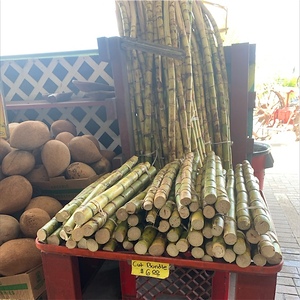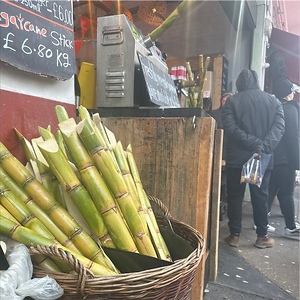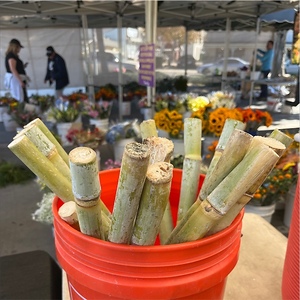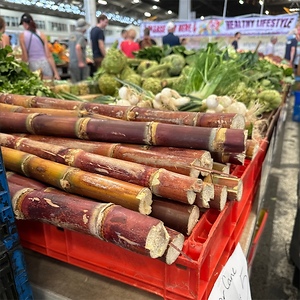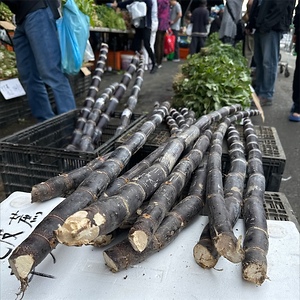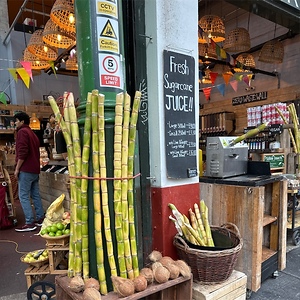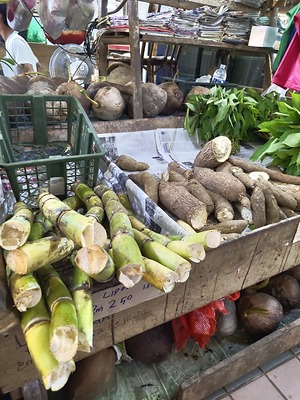

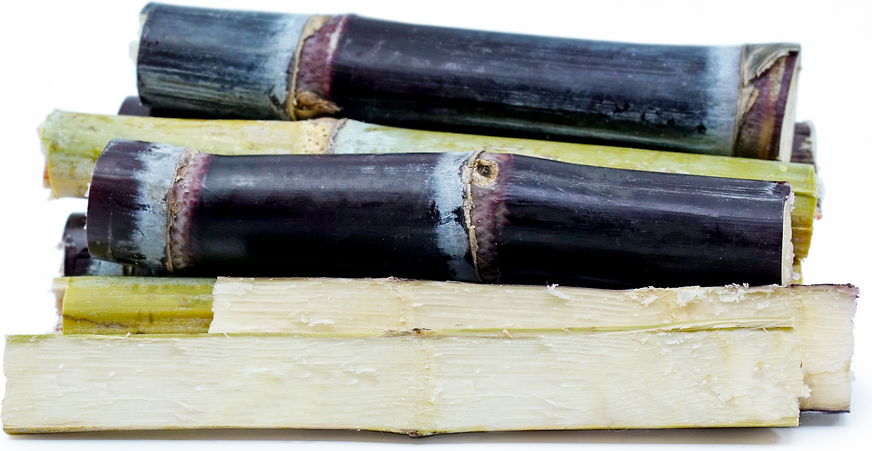
Purple Sugar Cane
Estimated Inventory, ea : 0
Description/Taste
Sugar Cane is medium to large in size, growing up six meters in height, and averages 3-5 centimeters in diameter with elongated stems and long, pointed leaves. The cylindrical stems have an outer layer that is smooth, hard, inedible, dark red-purple, and has white growth rings or joints that divide the stem into segments of different sizes ranging from 10-25 centimeters apart. The interior of the stem is pale gold, firm, juicy, woody, and fibrous. Sugar Cane offers a sweet and starchy taste with a raw vanilla flavor.
Seasons/Availability
Sugar Cane is available year-round in tropical climates and in the late summer through fall in climates with colder winters.
Current Facts
Sugar Cane, botanically classified as Saccharum officinarum, is a perennial grass that belongs to the Poaceae family along with rice, sorghum, and wheat. Sugar Cane is one of the world’s oldest cultivated crops and is a source of commercial sucrose, which is extracted by crushing the stem. The plant thrives in warm, tropical climates across the world and is favored by chefs and home cooks for its fibrous flesh and sweet, sugary liquid. There are many different varieties of Sugar Cane that range in appearance from white, green, to purple. Also known as the Purple Ribbon Sugar Cane, the Purple Sugar Cane depicted in the photo above is considered a “noble” variety and was created through back-crossing with a natural hybrid of black cheribon.
Nutritional Value
Sugar Cane is an excellent source of calcium, chromium, cobalt, copper, magnesium, manganese, phosphorus, potassium, and zinc. It is also a good source of fiber, vitamins A, C and B, and antioxidants.
Applications
Sugar Cane is best suited for both raw and cooked applications such as boiling. The flesh is chewed as a sweet treat to extract the juice, and then the fibrous cane is discarded. The stem can also be pressed to make cane juice or boiled to make pure cane syrup and raw sugar crystals. In addition to boiling and syrup production, Sugar Cane can be cut, sliced, and used as skewers for beverages, fruit kabobs, shrimp, meats, or on tray passed hors d’oeurves. It can also be used to make ice cream and cocktails. Sugar Cane pairs well with raspberries, pineapple, lime, cinnamon, plantains, peanuts, shrimp, fish, poultry, and steak. The stems will keep up to two weeks when wrapped whole, placed in a plastic bag, and stored on the bottom shelf of the refrigerator. They can also be frozen up to three months.
Ethnic/Cultural Info
The Purple Sugar Cane of today is not the original plant that was once found growing along the lush coast of Georgia in the United States. Around the turn of the 20th century, most of the sugar cane varieties growing in the American south were killed off by disease. Due to the loss of the plant, the culinary culture in the South also suffered because many of the traditional dishes were centered around the use of Sugar Cane and its distinct flavoring. In 2014, Purple Sugar Cane got a resurgence thanks to a partnership between Clemson University and a small, coastal Georgia family farm. Researchers and botanists worked to find a more disease resistant hybrid, using both cultivated and wild varieties. With the selection of a “noble” variety, which is a variety back-bred with an ancient variety, the sugar cane industry in the United States was saved, and traditional recipes for molasses and syrup were reintroduced using the plant.
Geography/History
Sugar Cane is believed to be native to tropical regions of Southeast Asia and was first domesticated in New Guinea around 8,000 BCE. It then spread to India and Oceania through immigration of emerging civilizations, and in 715 CE, Sugar Cane was established in the Middle East, Egypt, and later the Mediterranean via the crusades. Spanish and Portuguese explorers introduced Sugar Cane to the new world between 1400-1500 CE, and the plant became widely popular due to the warm climate and available land for cultivation. Today Sugar Cane is cultivated in tropical climates around the world, especially in Mexico, Thailand, Pakistan, China, India, Brazil, Puerto Rico, Hawaii, Louisiana, and Florida, and can be found at local markets and specialty grocers in North America, South America, Europe, Asia, Africa, and Australia.
Recipe Ideas
Recipes that include Purple Sugar Cane. One
| A Spicy Perspective |
|
Pineapple Sugarcane Water |
| Epicure Asia |
|
Purple Sugarcane Lamb Shank with Purple Butter Potatoes and Roasted Asparagus |



